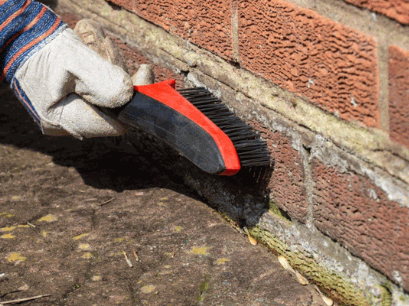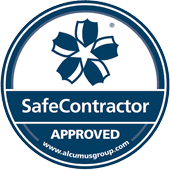Brickwork is a popular choice for buildings of all sorts, both residential and commercial, due to its durability and aesthetic appeal. However, finding white stains on brickwork is a common problem that can be unsightly and spoil its appearance. The most common cause of these stains is efflorescence, which is harmless but a sign of excess moisture. We'll go into what causes efflorescence, how to prevent it, and the best methods for removal.

If you see white stuff on your walls, the most likely cause is efflorescence. These are deposits of efflorescing salts left on the surface of your brickwork, but how do they get there? Let's take a look at the process.
Brick is quite porous and absorbs water easily. The water could come from external sources, like rain or groundwater, or internal sources, like humidity.
Any building material like brick, mortar, or concrete naturally contains water-soluble salts, such as calcium chloride and calcium sulfate.
When a lot of water is absorbed, deep into the brickwork, it starts to move through the masonry until it reaches the surface and evaporates. This evaporation leaves behind efflorescing salts in the form of a crystallised salt deposit on the surface.
The appearance is usually a white powder, but it can sometimes be a greyish or blueish stain.
Efflorescence on its own will not cause any structural damage to your building, but it can be a sign that there is a problem with water ingress or drainage, which could cause damage if left untreated.

Under normal circumstances, water will escape through the mortar. It is designed to be breathable to allow the movement of moisture without it penetrating into the brick. However, mortar will harden over time and lose its ability to breathe, which will force the moisture to escape through other building materials, like brick. This is where it will pick up the salt that will be left on the masonry surfaces.
Even if the mortar remains breathable, efflorescence can still occur. If the brickwork becomes completely saturated with water, it will penetrate deep into the brickwork and bring salts to the surface when it evaporates.
This excessive moisture can be due to poor drainage, improper or highly soluble building materials, or exceptionally wet weather.

Preventing efflorescence requires controlling how much moisture is able to penetrate the masonry, and can begin from the very start of the construction project onwards.
If you are concerned about efflorescence, you can protect yor building from it by using specific materials. Low-salt bricks and mortar can help to reduce the chances of salt deposits and are common solutions in the construction industry.
Ensuring that the mortar is well-mixed and cured properly reduces the chance of moisture infiltration, and low alkali cement can prevent efflorescence by counteracting the salt.
If you are dealing with recurrent efflorescence and moisture issues, you can prevent it by applying a water-resistant sealer to the brick surface. This is a breathable and water-resistant sealer that prevents the movement of water, and it evaporates on the surface.
You should proceed with caution before applying a sealer as it can make the problem worse. If you don't know the source of the water, you could cause it to pool in even more problematic areas.
Drainage is key to preventing efflorescence long-term. Directing water away from the masonry surfaces will remove the problem altogether.
The type of drainage you need to add will depend on where the water is coming from but can include gutters, drainpipes, and weep holes.
You can also add design elements that stop water from hitting the walls, such as overhangs and flashings.
Finally, ensuring that the area around your foundation has proper grading will direct water away from the building, rather than letting it pool at the base.
So far, we have looked at preventative steps to stop external moisture from causing efflorescence, but internal moisture is often overlooked, and it is usually caused by excess humidity. This is particularly seen in areas like basements and crawl spaces.
Vapour barriers will prevent water from moving through the masonry to the outside and proper ventilation will reduce humidity altogether.
Mortar joints are key to moisture control and preventing efflorescence. Keeping them maintained will help them to do their job properly, and includes periodic checking for cracks and other damage that could let in excess moisture.

Efflorescence is not harmful to the building's structure, but it does look unsightly, so many people prefer to remove it. There are a few different methods you can use to get rid of the salts, but it is always worth remembering that efflorescence can be a sign that there is a moisture problem in the building.
Ignoring this warning sign can allow the moisture to cause structural damage if left untreated. Spending some time investigating the source of the water and consulting a professional is always a good idea.
Read our post "How to clean brickwork".
Efflorescence will go away on its own through normal weathering, so if you are happy to just wait and let nature take its course, the problem will be solved for you.
Efflorescing salts are a white powder on the surface of the masonry units, and they can be removed through dry brushing. Take a stiff brush and simply brush the surface and the salt will come away.
Never use a wire brush on brick masonry as this can remove the brick's finish and leave the core exposed. You will be left with a mismatched appearance and brickwork that is even more vulnerable to moisture damage.

If there is still some staining left after dry brushing, you can use a wet method. Salt is water-soluble, so you only need water to remove it, but you can also add a mild detergent.
Use a damp sponge to wipe away the salt, rinsing regularly. The salt will dissolve in the water and lift away.
While water will remove efflorescence, you must not use too much. Over-saturating the brickwork will simply bring more salts to the surface and compound the problem.
Pressure washing is effective at removing efflorescence. It uses a high-powered stream of water to lift the salt deposits from the brick and dissolve them in the water. If you have large patches of efflorescence, this can be a more efficient method than using a damp sponge by hand. It can also get into small crevices that are difficult to clean by hand.
You should always be careful when pressure washing brickwork, however, as it is a powerful tool.
Saturating the bricks with water can make efflorescence worse, and focusing too much pressure can cause damage. For the bricks, this can take away the brick's finish and leave the core exposed. Mortar joints are especially vulnerable, and some of the cement can be chipped away, leaving cracks and openings for water to seep deep into the structure.
A professional pressure washing company, like London Power Washing Team, will have the training and experience to effectively use a pressure washer to remove efflorescence, without causing any damage to your masonry.

Most of the time, acid cleaners are not needed for removing efflorescence, as the salt is dissolvable in water. For very stubborn stains, phosphoric acid or muriatic acid can be effective solutions. Muriatic acid should be the absolute last resort because it is a highly toxic and dangerous chemical. If you have any doubts about using it, always consult a professional.
Don’t miss our post "How to remove paint from brick".
If you are dealing with stubborn efflorescence, we can help. Our team of highly trained and experienced technicians can remove this brick stain from your masonry effectively and without causing any damage.
We will carefully examine the brickwork to determine the nature and strength of the materials before choosing the most appropriate cleaning method to preserve the brick surface and mortar joints. We will also work with you to determine the source of the water ingress and develop a plan for prevention.

Efflorescence is caused by water evaporation leaving salt deposits on the surface of brickwork. It is often a seasonal problem during wet periods, and a long period of dry weather will stop it from happening, but the white stains can remain. Preventing efflorescence involves reducing the water that can enter the bricks, while removal can be done using dry brushing, water, pressure washing, or as a last resort, acid washing.




